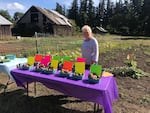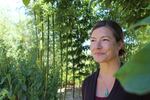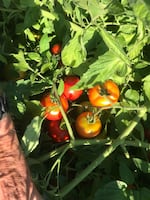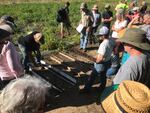Master gardener Darlene Gowen proudly stands next to a table full of tomatoes and potatoes she grew on her farm in Independence, Oregon.
“I'm finding that I have earlier and better crops for those things that I can actually dry farm, and I'm experimenting with crops that I didn't think I could dry farm, that are turning out to be better crops,” Gowen said.

Darlene Gowen has been dry farming for the past four years. This summer she grew a wide variety of crops using this technique, including tomatoes and potatoes.
Monica Samayoa / OPB
This past summer, Gowen successfully grew a wide variety of crops by using a sustainable technique called dry farming.
Gowen said her dry-farmed vegetables have better flavor than irrigated crops. That’s a big reason she wants to start weaning her crops from irrigation and moving forward with dry farming.
It’s not a new way of farming. It’s how farmers farmed before the rise of dams, irrigation pipes and central pivots.
Dry farming relies on the moisture that's stored in the soil from winter rainwater. It's successful in regions with at least 20 inches of annual rainfall and a summertime climate with cool mornings and warm afternoons.
Sounds like the Willamette Valley, right?
This is the technique Oregon State University Assistant Professor Amy Garrett used when she started her research in 2013.

Amy Garrett has been researching dry farming since 2013 and started her own case studies in 2015 in the Willamette Valley.
Chloe Marie Shaughnessy
“I got started in dry farming realizing that a lot of the small farmers I work with were on land with limited water rights or water availability. In some cases, no water rights,” Garrett said.
Oregon's water law has been in place for over 100 years. Its basis is "first in time, first in line" which is why so many new farmers have trouble accessing enough irrigation water for their crops.
That was an especially big problem during the 2015 drought, Garrett said, when many farmers that used surface water irrigation had their water cut off early.
Climate change also plays a huge role. It's caused by the burning of fossil fuels like coal and petroleum, which emit heat-trapping carbon into the atmosphere.
The Willamette Valley gets lots of water — about 40 to 50 inches of annual rainfall — but as the climate gets warmer, it reduces the snowpack, which melts into rivers and streams that farmers depend on for irrigation water each summer.

Dry farmed early girl tomatoes in Philomath, Ore.
Monica Samayoa / OPB
After studying Northern California growers’ success with dry farming, Garrett held her first field day in the Willamette Valley in 2015. She grew multiple varieties of tomatoes, potatoes, zucchini, winter squash and dry beans and to her surprise, nearly 100 curious farmers and gardeners showed up.
“The most common question I got at that field day was, ‘OK, so how many times did you water?’ I'm like, ‘Well, we didn't water. We planted early when there was still moisture, and we space things out wider, and we use these varieties based on their history and so forth,'” Garrett said. “And people were kind of flabbergasted as to how these plants could grow without water.”
There isn’t a precise recipe for dry farming; there are lots of farmers testing out creative ways to revive dry farming that work for their regions’ weather patterns and soil types.
“I think for so long we've been fertilizing and irrigating for maximum yield that the thought that a plant could even grow here in our dry summers without irrigation was kind of magical,” Garrett said.
According to her research, some of the benefits, besides using less water, include less labor, fewer weeds and better-tasting produce.
But there are downsides. Dry farming produces less per acre because plants need to be spaced out more in order to collect enough water from the soil.
And it’s not as simple as just walking out into any old field, planting some seeds and walking away. Soil variations and regions play a key role, too.
“If I was looking for a soil to dry farm, I'd be looking for a soil that's got very high water holding capacity, good fertility, no restrictive layers, and enough of it that you can make a farm out of it,” soil scientist Andy Gallagher said.

Soil Scientist Andy Gallagher demonstrates the different types of soils found in the Willamette Valley at a dry farming event in Philomath, Oreg.
Monica Samayoa / OPB
He said some of the best soils for dry farming are deep and have relatively high clay content, like in the Willamette Valley.
Since Garrett held her first field day in 2015, there’s been lots of interest from local farmers to learn more about this technique.
In 2016, the Dry Farming Collaborative was formed in the Willamette Valley, where growers on over 50 sites have been helping researchers collect valuable data to improve their methods.
And it’s also sparking younger generations to get involved.
Teenager Cydney Diaz recently learned about dry farming at one of Garrett’s events.
“I think it’s going to gain a lot of momentum, especially as different people are looking for alternative solutions to irrigation,” said Diaz, 17, who's been growing crops for the last couple of years on two acres outside of Lebanon.
Diaz said the program is great for farmers and people like her who want to find easier ways to produce food in a changing climate.
Diaz plans on testing out the dry farming technique next year in hopes that it will help her become a better farmer. But for now, she’s going to continue to have fun with agriculture — like growing carrots, potatoes and cauliflower in her favorite color.
“I’m really passionate about growing things that are purple, which my siblings hate!” she said.
